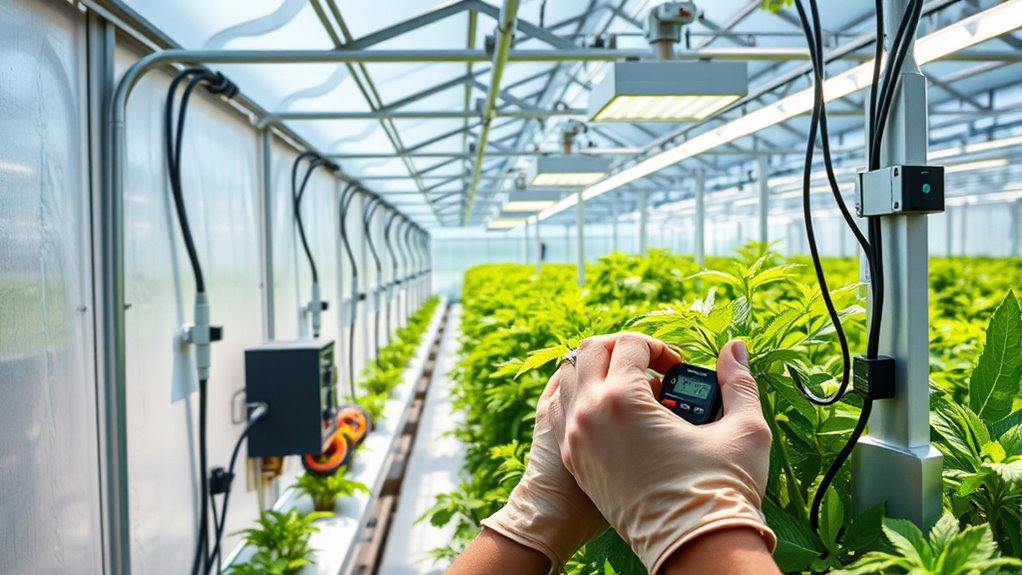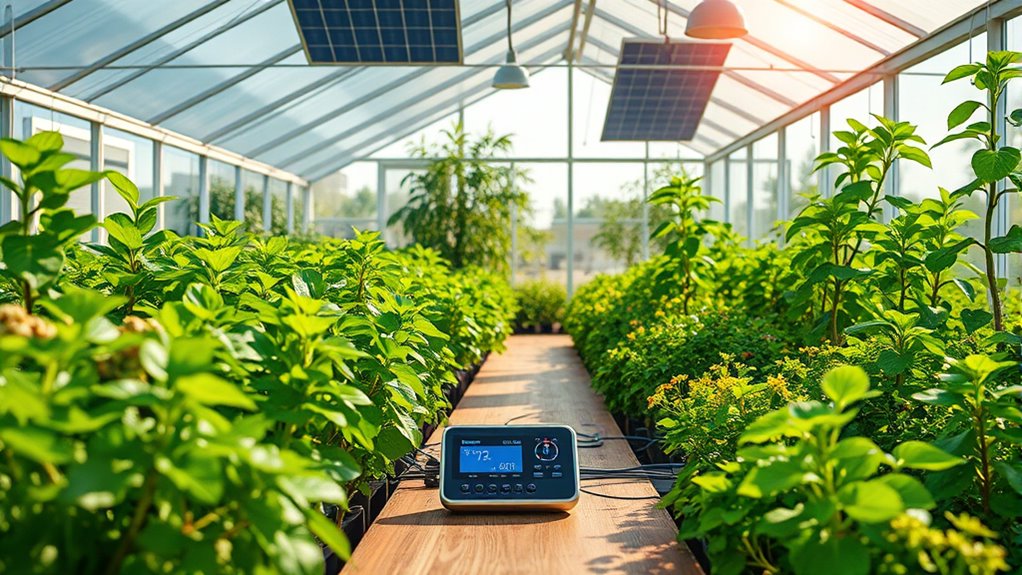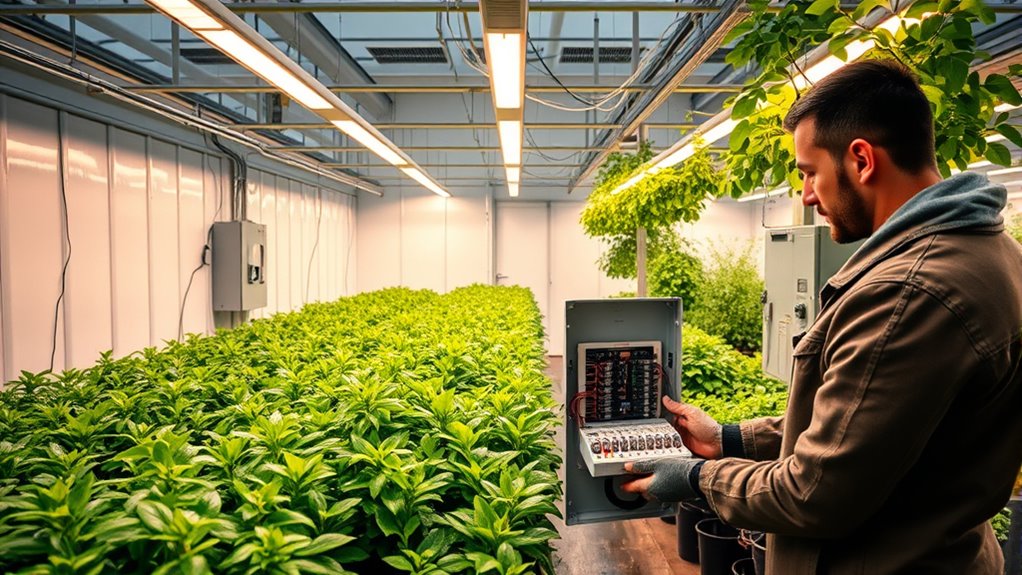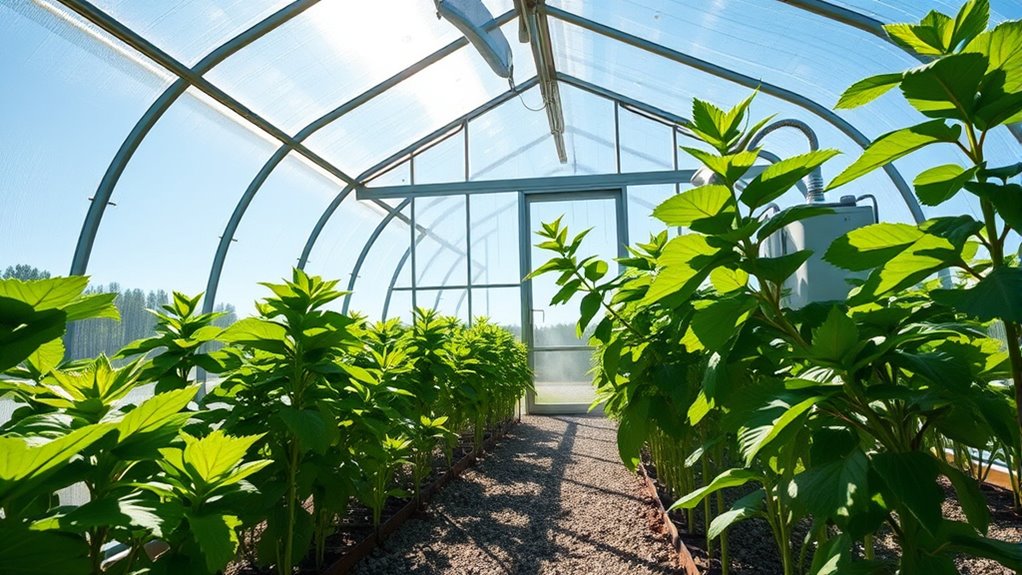Adding electricity to your greenhouse is crucial for maximizing plant growth and maintaining optimal conditions. Start by assessing your electrical needs based on the size and layout. Choose energy-efficient components like LED grow lights and GFCI outlets for safety. Plan the installation with proper site preparation to protect your cables. Don’t forget to incorporate energy efficiency measures, like solar panels, to reduce costs. Stay tuned to discover more about budgeting and future upgrades for your electrical system.
Key Takeaways
- Assess your greenhouse size and electrical load requirements to ensure adequate power for lighting, heating, and irrigation systems.
- Choose energy-efficient components like LED grow lights and ensure GFCI outlets for safety in wet conditions.
- Plan the electrical installation process by surveying the site and determining optimal locations for outlets and lighting.
- Follow NEC requirements for safety, and regularly inspect electrical installations for damage and compliance.
- Consider renewable energy options like solar panels to enhance energy efficiency and reduce operational costs.
Assessing Your Greenhouse’s Electrical Needs

How can you effectively assess your greenhouse’s electrical needs? Start by evaluating your greenhouse size and layout, as larger spaces demand more power.
Consider the placement of electrical panels to ensure they don’t block sunlight or ventilation. Plan for future expansion by accounting for potential growth, and divide your space into zones for efficient power distribution.
Carefully position electrical panels to maximize sunlight and airflow while planning for future growth and efficient power distribution.
Next, assess your electrical load demands; think about the power required for horticultural lighting, cooling systems, irrigation pumps, and heating systems.
Finally, factor in environmental influences like humidity, which can affect your design.
Selecting the Right Electrical Components

With a clear understanding of your greenhouse’s electrical needs, you can now focus on selecting the right electrical components to support those requirements.
Start by choosing efficient LED grow lights, as they consume less energy and reduce heat, cutting cooling costs. Plus, they often qualify for utility rebates and provide excellent light quality.
Next, pay attention to wiring; use larger wires to minimize voltage drops and opt for flexible PVC conduits to protect against moisture. Installing GFCI outlets ensures safety in wet conditions.
Lastly, consider future expansion by ensuring adequate circuit capacity and collaborating with a design engineer to create a scalable system.
This thoughtful selection will enhance both efficiency and safety in your greenhouse.
Planning the Installation Process

As you embark on the installation process, careful planning is essential to ensure a smooth and efficient setup. Start by assessing your greenhouse layout, determining the locations for outlets, lighting, and heating or cooling systems.
Think about future expansion needs and the structure’s material, which can affect installation.
Next, conduct a site survey to evaluate the terrain and identify obstacles like trees or slopes. This helps you plan the best cable route, whether overhead or underground.
Remember to dig trenches at least 500mm deep, using sand layers for cable protection.
Lastly, prepare the installation site by ensuring all holes are sealed and trenches are filled properly after the cables are installed. Your thoughtful preparation sets the stage for a successful electrical setup.
Ensuring Safety and Compliance

Ensuring safety and compliance in your greenhouse’s electrical setup is crucial to protect both your plants and yourself.
Follow the 2023 NEC requirements, which mandate GFCI protection for horticultural lighting, especially near water sources. Remember, NEC Article 547 doesn’t exempt greenhouses from these requirements.
Regularly inspect your electrical cords for damage and ensure all outlets are GFCI-protected. Store tools properly to avoid contamination, and keep electrical equipment away from moisture.
Utilize waterproof enclosures for added protection and ensure proper ventilation to prevent water entry. Additionally, consider implementing automation of security protocols to further enhance safety measures in your greenhouse environment.
Regular maintenance, training on electrical safety, and detailed documentation of installations will help you stay compliant and minimize risks.
Prioritize these measures, and you’ll create a safer environment for your greenhouse.
Implementing Energy Efficiency Measures

After establishing a safe and compliant electrical setup, it’s time to focus on enhancing energy efficiency in your greenhouse.
Start by installing solar panels or wind turbines to harness renewable energy, reducing your reliance on the grid.
Consider energy-efficient lighting like LEDs, tailored for plant growth and equipped with precision controls to optimize usage.
Implement automated climate control systems with IoT devices to track conditions and make real-time adjustments.
Ensure your greenhouse is well-insulated, using double-glazed windows and thermal screens to maintain temperature.
Lastly, invest in high-efficiency heaters and root-zone heating to minimize energy consumption. Additionally, integrating solar-powered irrigation systems can enhance crop yields while maximizing energy efficiency in your greenhouse.
Budgeting for Your Electrical Project

When you’re budgeting for your electrical project, it’s essential to account for all aspects of the installation, from equipment costs to compliance with local codes.
Start by sizing your electrical service to handle the load of all equipment, including heaters, lighting, and motors. Use demand factors to calculate your total load, and don’t forget to add 25% for future expansion.
Ensure your wiring meets the National Electric Code for safety. Consider the costs of utility hookups and permitting, as they can vary significantly.
Engaging experienced professionals can help optimize your budget.
Lastly, remember to explore farm rates, which may be less expensive than commercial rates, helping you manage ongoing electrical expenses effectively.
Planning for Future Upgrades

As you plan for future upgrades in your greenhouse’s electrical system, it’s crucial to consider both your current and anticipated electrical needs. Assess your demand load now and factor in potential equipment upgrades.
Using energy-efficient devices can help reduce overall power consumption, making room for growth. Design your electrical infrastructure with scalability in mind; ensure main panels have space for additional circuits and consider three-phase power if necessary.
Choose appropriate wiring, factoring in future communication lines and easy wire pulling. Incorporate smart technologies for automation and efficiency, and regularly review your plans to accommodate new equipment. Additionally, consider integrating solar-powered solutions to enhance sustainability and reduce reliance on traditional energy sources.
Maintaining Your Electrical System

Maintaining your electrical system is vital for ensuring safety and efficiency in your greenhouse. Start by ensuring your grounding system complies with local codes; it protects both equipment and personnel.
Regular inspections help you spot worn components and verify that everything operates smoothly. Don’t forget to lubricate motors and gearboxes to prevent breakdowns.
Troubleshooting should be left to qualified electricians, especially for issues like faulty wiring or malfunctioning motors. Prompt repairs minimize downtime and protect your investment.
Implement safety protocols, such as testing fuses and circuit breakers and providing electrical safety training for your team.
Lastly, maintain your backup power systems, like generators, to keep critical systems running during outages. Regular checks will ensure reliability and performance.
Frequently Asked Questions
What Permits Are Needed for Electrical Installation in a Greenhouse?
When you’re planning electrical installation in a greenhouse, you’ll likely need electrical permits to ensure safety and compliance with local regulations.
Depending on your location, building permits might also be necessary for structural integrity.
Don’t forget about zoning permits, which regulate the greenhouse’s placement on your property.
Check with your local authority for specific requirements, as these can vary greatly by community and may include restrictions from homeowners’ associations.
Can I Do the Electrical Work Myself, or Should I Hire a Professional?
When it comes to electrical work, you might think you can handle it yourself, but it’s best to let a professional take the reins.
Navigating codes and safety regulations is no small feat, and one misstep can lead to serious hazards.
Professionals not only ensure compliance but also save you time and headaches down the line.
In the end, investing in expert help gives you peace of mind and a safer environment overall.
How Can I Ensure My Greenhouse Is Energy-Efficient After Installation?
To ensure your greenhouse is energy-efficient after installation, focus on proper insulation and seal any gaps to minimize heat loss.
Use energy-efficient materials for your frame and glazing options, like twin wall polycarbonate. Incorporate thermal mass with materials like concrete for added heat retention.
Regularly perform energy audits and maintain your systems.
Consider automated ventilation and shading systems to optimize conditions and reduce energy consumption, keeping your greenhouse sustainable and cost-effective.
What Specific Tools Are Required for Electrical Installation in a Greenhouse?
Installing electrical systems is like building a solid foundation for a house; you need the right tools.
For electrical installation, you’ll need wire strippers, a voltage tester, pliers, and a drill. A conduit bender helps shape the conduit, while a fish tape assists in pulling wires through.
Don’t forget a multimeter for measuring voltage and current. With these tools in hand, you’ll be well-equipped to tackle your electrical project effectively.
How Often Should I Schedule Maintenance Checks for My Greenhouse’s Electrical System?
You should schedule maintenance checks for your electrical system at least annually, but consider seasonal checks to ensure everything runs smoothly during peak usage.
Different components might need varying frequencies based on their usage and environmental conditions.
Keep detailed records of all maintenance activities to track performance over time.
It’s also wise to schedule maintenance during lower production periods to minimize disruptions and maintain efficiency.
Conclusion
As you step back and survey your newly electrified greenhouse, the soft hum of equipment brings life to your plants. The gentle glow of lights illuminates the vibrant greens, hinting at the harvests to come. But wait—what’s that flicker in the corner? Could it be a sign of something more? Every shadow holds potential, every sound sparks curiosity. With careful planning and a watchful eye, you’re not just growing plants; you’re nurturing possibilities.









